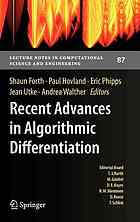

Most ebook files are in PDF format, so you can easily read them using various software such as Foxit Reader or directly on the Google Chrome browser.
Some ebook files are released by publishers in other formats such as .awz, .mobi, .epub, .fb2, etc. You may need to install specific software to read these formats on mobile/PC, such as Calibre.
Please read the tutorial at this link: https://ebookbell.com/faq
We offer FREE conversion to the popular formats you request; however, this may take some time. Therefore, right after payment, please email us, and we will try to provide the service as quickly as possible.
For some exceptional file formats or broken links (if any), please refrain from opening any disputes. Instead, email us first, and we will try to assist within a maximum of 6 hours.
EbookBell Team

4.3
8 reviewsThe proceedings represent the state of knowledge in the area of algorithmic differentiation (AD). The 31 contributed papers presented at the AD2012 conference cover the application of AD to many areas in science and engineering as well as aspects of AD theory and its implementation in tools. For all papers the referees, selected from the program committee and the greater community, as well as the editors have emphasized accessibility of the presented ideas also to non-AD experts. In the AD tools arena new implementations are introduced covering, for example, Java and graphical modeling environments or join the set of existing tools for Fortran. New developments in AD algorithms target the efficiency of matrix-operation derivatives, detection and exploitation of sparsity, partial separability, the treatment of nonsmooth functions, and other high-level mathematical aspects of the numerical computations to be differentiated. Applications stem from the Earth sciences, nuclear engineering, fluid dynamics, and chemistry, to name just a few. In many cases the applications in a given area of science or engineering share characteristics that require specific approaches to enable AD capabilities or provide an opportunity for efficiency gains in the derivative computation. The description of these characteristics and of the techniques for successfully using AD should make the proceedings a valuable source of information for users of AD tools.